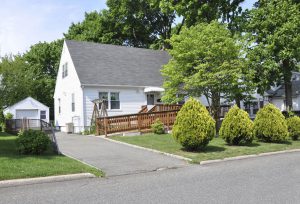
A home is foundational to our well-being. For most, our home provides us with a sense of security, safety, and a place where we most often spend time with our loved ones. To me, this means having a roof over my head, safe running water, protection from weather extremities, and creating memories with my family and friends. We all define and describe what home means to us in different ways, but we share the common understanding that home is at the core of our daily lives. Purchasing or renting a home tends to be the single greatest expenditure Americans make. Our home can also play a role in shaping our health and well-being. However, as we and our loved ones continue to live longer than our parents and grandparents before us, we can also expect to experience disability, such as mobility limitations that require assistive equipment like a wheelchair, walker, or cane. When homes include steps to the main entrance, have no bathroom on the first floor, and the door widths are too narrow to accommodate a wheelchair, our home, our very core, is disrupted and negative consequences can occur. To shed some light on this issue, inclusive design approaches like having a visitable home can prevent us from having to leave our home and move into an assisted living facility. Visitable Montana defines a visitable home, or visitability in three parts: 1) home has a zero step path of travel from the main entrance of the home to the street, sidewalk, or driveway; 2) doorways that are a minimum of 32 inches wide and hallways that are at least 36 inches wide on the main floor; and, 3) basic access to at least a half bathroom on the main floor. Accessible design of homes can support people to age in place, to have increased independence and to be socially connected to friends and family.
At some point in our life, we may experience disability, and that experience increases as we age. The idea that we spend many years and dollars to build our ideal home is a fact for many Missoulians, and the work we put into our homes is a major accomplishment. Another common experience as we age is that our family, if not ourselves, may experience injury that requires the temporary or permanent use of a wheelchair, crutches, etc. What happens next? You have steps to your front entrance, and when you finally make it up the steps without further injuring yourself or the person helping you up the stairs, the door width is too narrow for a wheelchair to enter. So, you go around to your side entrance and finally manage to make it into your home only to realize your bathroom is on the second floor. More steps. Later on in the evening you’re invited to a friend’s birthday party, but cannot attend as their home is not visitable. The person using the wheelchair may feel like a burden to his or her family and therefore choose to avoid social interactions that impose considerable barriers for him or her. Would this vignette be any different if we were to replace these homes with visitable homes? Easy answer, yes! With visitable homes, there are zero-steps to the front entrance, the door widths are at least 32” wide and hallways are at least 36” wide and you have a bathroom large enough to accommodate a wheelchair. The wheelchair user is able to maneuver up to the front door and use the bathroom, ideally without help or very limited help. For that birthday party invite, now attendance is possible because their friend’s home is visitable.
Visitable homes are meant to include everyone, but what about the health and well-being benefits? Healthy People 2020 is a national data source that provides science-based objectives that aim to improve the health of all Americans. The following objective focuses on the home: DH-11 Increase the proportion of newly constructed and retrofitted U.S. homes and residential buildings that have visitable features. Visitable homes reduce the possibility of falls, increase independence, and prevent isolation. The risk of falling can be heightened for all people when steps are present. Older adults are especially more at-risk for fall-related injuries (e.g., hip fractures) and mortality. Common causes for increased risk of falls include lower body weakness, difficulties with walking and balance, vision problems, foot pain, and home hazards or dangers such as broken or uneven steps, throw rugs or clutter that can be tripped over, and having no handrails along stairs or in the bathroom.
Visitable homes support older adults with and without to disabilities to age in place. According to research, aging in place is, “remaining living in the community, with some level of independence, rather than in residential care.” Living independently in one’s home, versus living in an institution, promotes life satisfaction, health, and self-esteem among older adults as home is familiar, comfortable, and has inherent meaning. Furthermore, according to urban planner, Jordana Maisel, M.U.P., with the University of Buffalo and Research Associate for the Rehabilitation Engineering Research Center on Universal Design, older adults are more likely to be active participants in their community and report life satisfaction more often if their home meets or somewhat meets their needs. Problems with building design were identified as the most common barriers to community participation among adults with and without disabilities (Maisel et al., 2008).
Inclusive design of homes, such as visitability, is currently a priority in Missoula. After considerable effort of advocating and providing education and information to legislators, housing experts, builders, architects and others about the housing needs of people with mobility impairments, Missoula has begun to make some strides in encouraging the building of visitable homes. On April 7, 2014, Missoula City Council unanimously passed Resolution 7869, which incentivizes visitable homes to be built in Missoula by giving priority in project approvals to builders applying for permits that voluntarily adopt Visitability standards.
